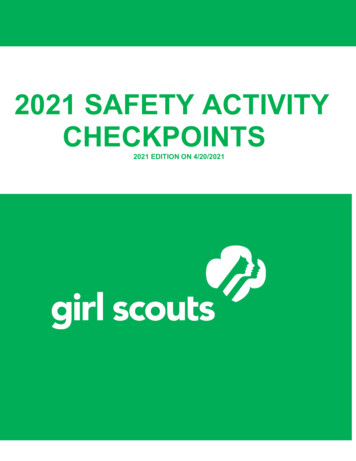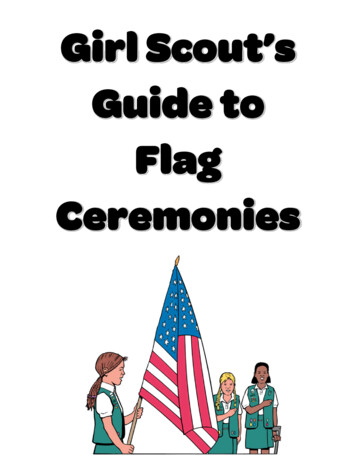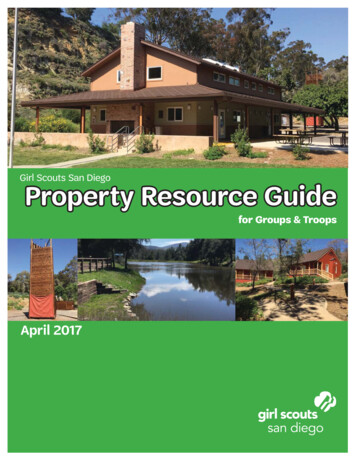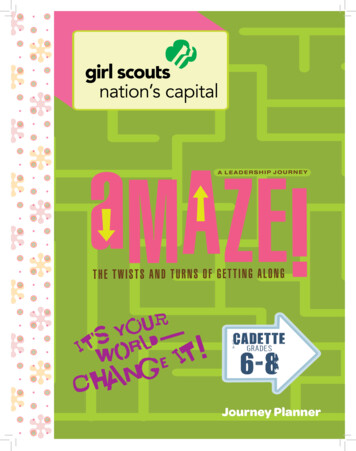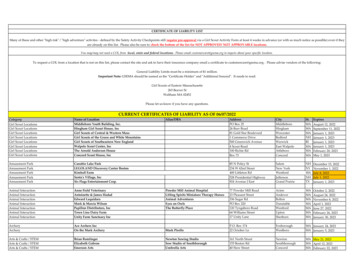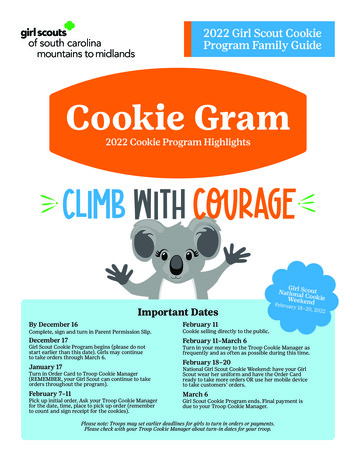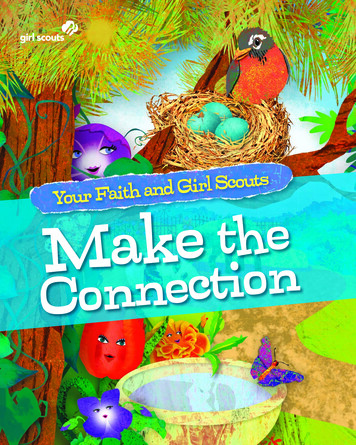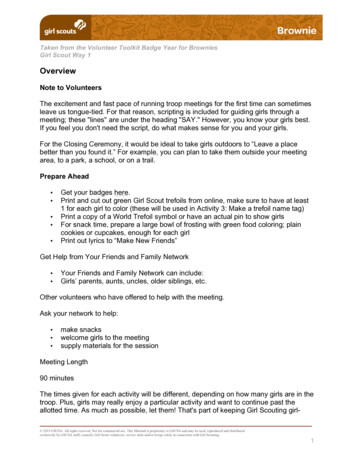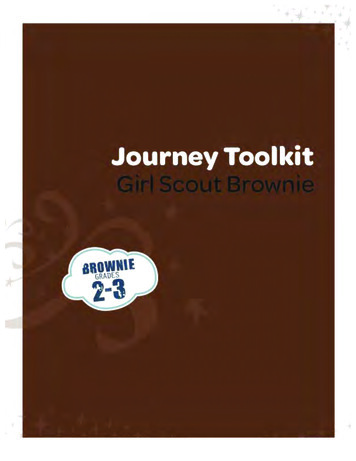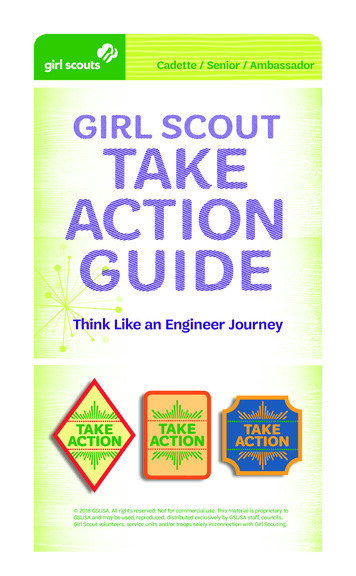
Transcription
Cadette / Senior / AmbassadorGirl ScoutTAkeActionGuideThink Like an Engineer Journey 2018 GSUSA. All rights reserved. Not for commercial use. This material is proprietary toGSUSA and may be used, reproduced, distributed exclusively by GSUSA staff, councils,Girl Scout volunteers, service units and/or troops solely in connection with Girl Scouting.
ContentsTake Action: Your Path to Silver and Gold. . . 1How to Make Your Project Sustainable. 4Your Take Action Talent Inventory. . . 8Your Take Action Decision Bracket. 10Finding Take Action Inspiration. 14Take Action Project Examples . 16Take Action:Your Path toSilverand GoldYou develop important skills when you do a Take Actionproject—and you use those skills to help others.That’s inspiring!When you Take Action, you learn how to: Advocate for change Analyze data Communicate withothers Craft persuasivearguments Create budgets Design forsustainability Develop timelines Empathize with others Give presentationsand speeches Make good decisions Manage projects Negotiate with others Research root causesof issues Solve problems Think critically Work as a team1
These are exactly the kind of skills that colleges,universities and businesses hope to find on collegeand job applications!They’ll also give you a strong foundation for earningthe Silver and Gold Awards, two of Girl Scouts’ highestawards. That’s because Take Action projects help youdevelop as a leader.By doing a Take Action project, you may also discoveran issue that’ss especially meaningful to you and thatyou’d like to expand to earn your Silver or Gold Award.To do this, think about how you can amplify whatyou’ve already done—how can you help more people,get more support from other organizations, reachinto new communities, or find other ways to lift yourTake Action project to the level of a Silver or GoldAward project.As a Silver Award Girl Scout, you’re advancing on the pathto leadership and are eligible to earn your Gold Award. As aGold Award Girl Scout, you’ve achieved the highest awardin Girl Scout and are eligible to be selected as a YoungWoman of Distinction.And it all starts with Take Action!the benefitsof Going GoldHigher Education and Career Distinguish yourself in the college admissions process Earn college scholarships Enter the military one rank higherLife Skills Be seen as a role model and distinguished leader Master time management skills Make the world a better placeCommunity Use your vision for change Tackle an issue, locally or globally Establish a lifetime network Create your community legacy with a sustainablesolution to a problemAs a Cadette, you can earn the Silver Award with asmall team of girls or on your own. As a Senior orAmbassador, you earn the Gold Award by creatingan individual project and organizing a support team.Ready to get started? Turn the page to find out howyou can design a project that has lasting impact.23
How toMake YourProjectSustainablePeople sometimes wonder about the differencebetween a community service project anda Take Action project. Here’s how you can explainthis to others:When you Take Action, you work as a team to: Identify a problem Research the root causes of the problem Come up with a sustainable solution Develop a team plan Put the plan into action Reflect on what worked, what didn’tand what you’ve learnedHere are three ways to create sustainable change:Community Service makes the world better byaddressing a problem “right now.” For example,collecting cans of food for a food pantry will feedpeople “right now.” Gathering toys for a homelessfamily shelter will make kids happy “right now.”Providing clothing and toiletries to people after afire or flood will help them “right now.” These actsof kindness are important ways to help people —right now.Take Action makes the world better by coming upwith a solution that is sustainable. That means thatthe problem continues to be addressed, even after theproject is over. Developing a sustainable solution isthe key difference between community service andTake Action projects.1 2 3Make yoursolutionpermanent.Educateand inspireothers tobe part ofthe change.Changea rule,regulationor law.5
Create a digital survey.Here’s an example of how to go beyondcommunity service in order to Take Action:Your team has identified a problem: there’s toomuch trash in the local park. If you go to the park andpick up trash, you will have solved the problemfor today—but there will be more trash to pick uptomorrow. That’s not sustainable.So what do you do?Explore why there’s so much trash. Here are a fewways you might do that:Talk to people who work at the park in differentkinds of jobs, from park manager togroundskeeper. What do they already know aboutwhy there’s so much trash? What do they think causes this problem? What solutions have they already tried? If those solutions didn’t work, what did they learn?Do a walk-through of the park to understand whatvisitors experience. How far do you have to walk to find a trash can? How easy is it to find a trash can? Is it difficult or easy to collect your trash and carryit around the park?Interview park visitors about their experience. Why do they think there’s a trash problem? What are their ideas about how to fix it? Record their answers and add them to your research. Use social media to encourage people to sharetheir complaints and ideas for solutions. Take your tablet to the park and ask people to takeyour survey in real time. Analyze your data and use them to brainstormsolutions.Research the kind of trash problems that all parks—from community parks to national parks —deal with. Are there any studies or articles about how parkshave tried to fix the problem? Which solutions worked and why? Which ones didn’t and why?Here’s what you might discover: There aren’t enough trash cans in the park. T here are enough trash cans—but they’re hardto find. T he trash cans are not placed in convenientlocations, so people have to walk out of their wayto throw away trash. P eople don’t realize the importance of putting trashin the trash cans.Here’s how you might address these issues: M ake a presentation to the city council to presentyour data and advocate for your chosen solution. C reate an anti-littering public awareness campaign. D esign and build interactive garbage cans thatmake it fun to toss away trash. (For inspiration:Search online for “the fun theory” or “the world’sdeepest bin.”)Turn the page to start exploring your own.67
Check each talent or interest you can use toTake Action—then add a few more!Your TakeAction TalentInventoryWhat are your talents—painting portraits, coding,creating fun events, public speaking, writing, organizinggroups of people, creating budgets, speaking anotherlanguage, playing a musical instrument?What do you do for fun—skateboarding, buildingdrones, sewing costumes, cooking, doing karaoke, hiking,playing games on your phone, listening to music?You can use what you’re good at (your talents and skills)and what you do in your spare time (your interests)when you design your Take Action project. You’ll havefun and people will be inspired by the enthusiasm youbring to your project. create a comic start a blog design a website code an app develop a workshop design a prototypefor a new invention organize a volunteereffort design a video game create an onlineclass create digital surveysand analyze the data create a social media create a data basecampaign make an infographic hold a storytelling organize a “girl-ledtalks” eventfestivalcommunitycommunity event build a maker space advocate for a newlaw organize a paneldiscussion or debate change an existinglaw make a movie build a playground design an exhibit create an art gallery write a book organize a organize an online Other ideas: create an artwork invent a new product make a playbook create a ’zine circulate a petition create a volunteergroup invent a new processHow can you match your talents and interests withan issue you care about? Turn the page to find out!89
racketision BceDntioExample:ake AcTake Action Decision BracketYour Tyou?othersWhat b blems do yourooWhat p to solve? Whlptnheawtotnawdo youSTEP 2.Fill in theseboxes.STEP 1.Fill in theseboxes.onbullying ediamlsociatalentsre yourWhatatahWills?and sk o for fun?duoydotexting ginand drivmaking g nsatiopresentplaying rathe guitcreatingappsouthanging ndsierwith f10okids wh dsnieneed frcookingcookingcreatingFor eachbracket,choose one.ed petsabandon-schoolno after clubSTEMtexting ginand driv-schoolno after clubSTEMusdangerotioncesrinteappshtoo muc rkowehomher’smy brot ginsateusdangerotioncesinterplaying rathe guitSTEP 3.okids wh dsnieneed frtexting ginand drivcookingplayingllvolleybatexting ginand drivusdangerotionceintersappscreatingSTEP 4.Continue untilyou have a finalpair. Combineto createyour project.In this example, your Take Action project mightbe to create an app that locks your phonebefore you drive, then sends a unique code tosomeone who’s not in the car. You can’t use yourphone until the person with the code unlocks it.11
What are your talentsand skills? Whatdo you do for fun?12Your TakeActionDecisionBracketWhat bothers you?What problems do youwant to solve? Whodo you want to helpCombine thefinal pairto create yourTake Actionproject!Want more Take Action projectexamples? Turn the page!13
Find out what other Girl Scouts have done. ManyHow to FindTake ActionInspirationFollow the news. Watch TV news, read newspapersand magazines, listen to the radio, follow social media,subscribe to blogs or news feeds—it doesn’t reallymatter how you tune into what’s happening in theworld. What matters is that, when you do, you hearinspiring stories about people who: stood up and spoke out to advocate for change invented a product—such as a language-learningapp, new medical device, or robot that assistspeople with disabilities—that helps others created bonds between people of differentbackgrounds so they could solve problems together built something useful—such as a bike path,playground, public garden, or maker space—toimprove their communityKeep a list of stories that inspire you. Is there a way toaddress the same issue or use a similar approach toTake Action in your community?Take Action and Silver Award projects are posted onGirl Scout council web sites and social media. You canalso attend council recognition ceremonies and meetother Girl Scouts who took action in meaningful ways.Fill out Your Take Action Talent Inventory onpage 8. You’ll be inspired to Take Action—and havemore fun!—when you create projects that use yourtalents, interests, and hobbies to change the world.Try out Your Take Action Decision Bracket onpage 12. Use this interactive exercise to combine ofyour talents/interests and the issues you care about.Play as many times as you like—you may be surprisedby the ideas this generates!If you’re working with a team of girls on a Silver Awardproject, this could be a fun way to narrow down yourideas. If you’re working solo on a project, this is a goodway to quickly come up with lots of possible “talent/issue” combinations.Get inspired by some Take Action projectexamples, starting on page 16. Some are actualprojects done by Girl Scouts; others are examplesthat can serve as thought-starters. Use them asinspiration as you explore the problems you want toaddress in your own community.Once you’ve chosen an issue you feel passionateabout, it’s time to put your imagination, creativity andleadership skills to work—and come up with your ownway to Take Action!Turn the page for examples of Take Action projects.1415
The following examples are thought-starters.Use them as inspiration as you develop a projectabout something that you care about.Take ActionProjectExamples1Solution: Partner with a community center or libraryto create a maker space. Encourage communityinvolvement by inviting people to donate old techdevices, recyclable cardboard, leftover boards orsandpaper, tools such as hammers or screwdrivers,etc. Create a “Maker Space Playbook” that includestips for running a maker workshop, project ideas, anddesign challenge topics. Recruit members of collegeengineering societies, robotics teams, and artists todeliver workshops.In the Think Like an Engineer Journey, you learnedabout the design thinking process—how engineerssolve problems.When you develop a Take Action project, you can usewhat you learned: how to identify a problem, researchwhat causes the problem and how you might helpsolve it, develop a possible (or prototype) solution, andput it into action. If your chosen solution doesn’t workright away, you tinker with your prototype, usingfeedback to make it better.The Take Action project you do as part of this Journeydoesn’t necessarily have to be about engineering(although it certainly can be!). You may choose toaddress issues related to mental or physical health,food scarcity, civic engagement, the environment,online safety, and so on. If you use the design thinkingprocess to develop your project, you will be thinkinglike an engineer—and making the world a better place.Issue: More people of all ages are interested inmaking and tinkering. However, communities don’talways have places to do hands-on activities, whichare a great way to get children interested inengineering (and give their families something funto do as well!).Sustainability: Make your solution permanent;educate and inspire others.2Issue: Elementary school children don’t have theopportunity to learn engineering through hands-onactivities.Solution: Organize a workshop at a community centeror library where children can do different engineeringprojects. Develop a playbook, including projectinstructions, a supplies list, and tips for recruitingfacilitators, so that the workshop can be replicatedin the future. Share the playbook online and usesocial media to let others know about the resource.Sustainability: Educate and inspire others.1617
34Issue: Farmers need to conserve water duringdroughts while also sustaining their businesses.Solution: A Girl Scout Ambassador from NorthernCalifornia developed soil moisture sensors and readers tohelp farmers conserve water and use less groundwater.The sensors are planted into the soil; they allow farmersto read and determine the moisture level in the soil.Based on this technology, farmers on average saved25 percent of their monthly water use. She’s in theprocess of patenting her product and has created aFacebook site and video log to show others how theycould replicate it globally.Sustainability: Make your solution permanent.Solution: Identify and interview the “hidden figures”in your community to create an oral history. Film ortranscribe the interviews, then donate thedocumentation to a local museum or library topreserve the history for future generations.Issue: More students would be interested in engineeringif they saw how it connects with art and creativity.Sustainability: Make it permanent, educate andinspire others.Solution: Create a kinetic sculpture garden at a school,community center or library. Use the playful sculpturesas a way to introduce others to engineering by givingtours, creating signs explaining the engineeringprinciples used in creating the sculptures, or creatingan instructional handout for visitors who want tomake their own sculpture.Sustainability: Make your solution permanent.56Issue: The book and movie Hidden Figures: TheAmerican Dream and the Untold Story of theBlack Women Mathematicians Who Helped Winthe Space Race celebrated women who madeimportant contributions to the American spaceprogram, yet went unrecognized for decades. Thereare women in many communities who haven’tbeen recognized for their contributions to society,whether in the areas of STEM, social justice,advocacy, or caregiving.Issue: Middle school girls—and their parents—arenot always aware of the many engineeringscholarships, college programs or other opportunitiesavailable to them.Solution: Partner with a middle school guidancecounselor to develop a career exploration workshopfocused on engineering. Develop a facilitator’sguide so the workshop can be replicated in the future.7Issue: Communities are often economically andracially segregated, which can lead to a dividedcommunity.Solution: A Girl Scout Ambassador in Florida used herhospitality skills to mitigate tensions in her raciallyand economically diverse area by building bridgesamong her peers. With the help of her support team,she hosted a dinner party for 120 students from12 public and private high schools. The dinner partybrought everyone together for critical conversationsabout how to prevent bullying and strengthenrelationships that promote peace, equality, truth, andunity, both among the students themselves and withinthe community at large.Sustainability: Educate and inspire others.Sustainability: Educate and inspire others.1819
8Issue: When children are chronically exposed tonicotine and smoke, their health suffers and theirchances of becoming a smoker greatly increase.11Solution: Five Girl Scouts in Colorado used what theylearned on the Breathe Journey for their Take Actionproject. They championed and passed an ordinancethat made smoking in a vehicle while a minor ispresent subject to community service or a fine. Theban, passed by the Aurora City Council, is the first ofits kind in Colorado.Solution: Everyone’s heard of TED Talks, the inspiringand informative speeches given by people with amission to change the world. Create a “Girl-Led Talks”event that features girls speaking out on an issuethey care about. Film the talks and post them to anonline site to spread the word far and wide.Sustainability: Change a rule, regulation or law.9Sustainability: Educate and inspire others.Issue: When students with anxiety disorders areoverwhelmed by feelings of fear or sadness atschool, their learning suffers.Solution: A Girl Scout Ambassador decided to createa sensory room—a quiet, calming space where peoplecan take a moment to refocus—for her school. Shepresented her idea to the principal. Not only didshe get permission, but the school district’s board ofdirectors gave her a grant for the project. Within ayear, almost a quarter of the student body had usedthe room at some point.Sustainability: Make your solution permanent.10Issue: Name the issue—ocean-polluting plastics,middle-school bullying, girls opting out of STEMclasses, homeless families, the health risks of obesity,the need for citizen engagement, the danger ofcybersecurity breaches, and so on—and you’ll findgirls who want to find a solution.Issue: More girls could have fun and stay fit if theyknew how to kayak (or canoe, hike, bike,backpack—pick your favorite sport!)Solution: Create a one-day event to give girls a chanceto try the outdoor activity you love the most. Partnerwith a local business or outfitter to get equipmentand instructors to help. Create a playbook so that otherscan replicate your event’s success in the future.Sustainability: Educate and inspire others.2012Issue: It’s difficult to see stars and planets atnight—even in a park—if there are too many streetor other man-made light sources nearby.Solution: A Girl Scout Ambassador from Virginiadecided to get a state park designated a “dark skypark” by the International Dark-Sky Association. A“dark sky park” has a protected nocturnal environmentthat leads to clear, starry sky views. To earn herGold Award, she changed the park’s lights and addedmotion sensors and shields so they didn’t emitas much light. She also created posters for the parkcabins to let visitors know how the changes werereducing light pollution.Sustainability: Make your solution permanent;educate and inspire others.
Change theWorld—ThroughEngineering!Engineers can: give people access to clean water invent new medical devices design eco-friendly buildings help farmers grow more food design more efficient transportation and much more!
discussion or debate make a movie design an exhibit write a book organize an online community create an artwork invent a new product make a playbook create a 'zine circulate a petition create a volunteer group invent a new process organize a volunteer effort design a video game create an online class

